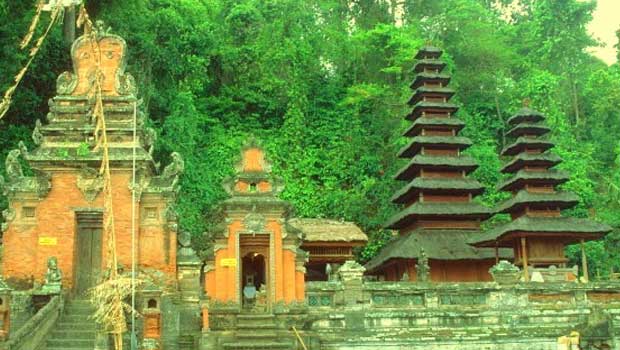Next to the natural wonders of Bali such as beaches and coral reefs, the temples are its next-biggest attraction. They’re picturesque, exotic, historic, and world-famous. Some of them get thousands of visitors per day. But they can be baffling, too. We’ll try to demystify temples in Bali with this handy little guide:
A very brief overview of Balinese Hinduism
Hinduism is easily the most complicated religion in history. It appears to be polytheistic, meaning that there’s many gods, but also all gods are said to be one god in many forms, rather like the Judeo-Christian trinity. Furthermore there’s sub-castes of gods; there’s a trinity of Brahma, Vishnu, and Shiva, and then there’s the lesser Vedic gods who resemble ancient Roman / Greek gods in being associated with some aspect of nature. Hindus also believe in reincarnation, and Balinese Hinduism is further complicated by the mixing in of some animism and ancestor worship on the side. There is also a different attitude towards sexuality, tending to view it as holy worship rather than a shameful sin as with Western religions.
The bottom line is, there’s a lot of statues, and some of them may have four heads, six arms, a tail like a fish, exposed breasts, a head like an elephant, and so on. If you come from a culture with a shy view of sexuality, brace yourself for some nude statue imagery. This is the religion which gave us the kama sutra, after all. Also, if you see a symbol here and there that resembles a swastika with four dots inside the arms, it is not meant to invoke Nazis; it is a Sanskrit good luck symbol used centuries before the Nazis co-opted it. Mistaking it for Nazi symbolism will get you some very dirty looks.
By custom, you will not be allowed to visit a temple without wearing a sarong and sash. But you can usually buy or rent these in Bali, or it might be handier to buy your own set if you intend to do a lot of temple-hopping.
Be respectful when you visit Balinese temples, and remember that this is somebody’s church. Listen to your tour guide and be sure to follow the rules and be as unobtrusive as possible.
Temple basics
There are three kinds of temples, sort of aligned with the concept of castes: “pura puseh”, a “pure” temple, “pura desa”, the “common” temple, and “pura dalem”, the “limbo” temple. Another way to think of them is “birth, life, and death”. Villages customarily have all three, with different functions associated. There are also nine major temples which are seen as Bali’s protection from evil forces.
- Besakih, the most important “mother temple” built on the slope of Mount Agung
- Uluwatu, at the southern tip of Bali near Kuta
- Tanah Lot, on a rock island just off the coast near Denpasar
- Ulun Danu Bratan, at Lake Bratan in Bedugul
- Ulun Danu Batur, near Lake Batur in Kintamani
- Lempuyang Luhur, east of Tirtagangga on the slopes of Mount Lempuyang
- Goa Lawah, right on the beach in Candidasa
- Pura Masceti, in Klungkung, southeast of Ubud
- Luhur Batukaru, at Taman Ayun in Tabanan
Even if you can’t make one of these, there’s many more temples besides. Some of these are temple complexes, with little temples for each temple. Quite a few of them are recognizable by their layered, peaked, thatched, pagoda-style roofs.
Temple design
No two temples are exactly alike, since some of their layout depends on the landscape. But they will usually be separated into an outer, middle, and inner courtyard. They will always have the entrence so you walk in facing towards Mount Agung. They will always have several shrines scattered around for various deities.
The outer courtyard is the commoner area, and not only can non-Hindus enter, but you might find vendors setting up shop here or villagers holding a dance festival. There are also raised seating sections here. Through a gate is a kind of kitchen-looking middle courtyard, where offerings to the temple’s gods are prepared. There might also be a pavilion where ceremonial acts are performed. Through yet another gate is the inner courtyard and the shrines, where non-Hindus are usually not permitted. Tourists may even be excluded from the whole place depending on what kind of ceremony, ritual, or holiday they have going on.
Some temples, especially the ones seeing heavy tourist traffic, may charge an offering, offer a guide for you to hire, or even include you in a ceremony and invite you to pray. Like churches, mosques, and synagogues in the rest of the world, they may differ from one place to another in customs. The larger ones, especially Besakih, have a small city of shops around them. Also, temple complexes may have a small city of temples, with some dedicated to a specific god, others for use only by a certain caste, and so on.
Trying to visit every temple in Bali is a superhuman feat. You might get burned out long before you are done. However, the more richly decorated and elaborate ones are an amazing sight to behold, and a tour through Balinese temples is an enriching cultural experience not to be missed by even the most hurried traveler.





